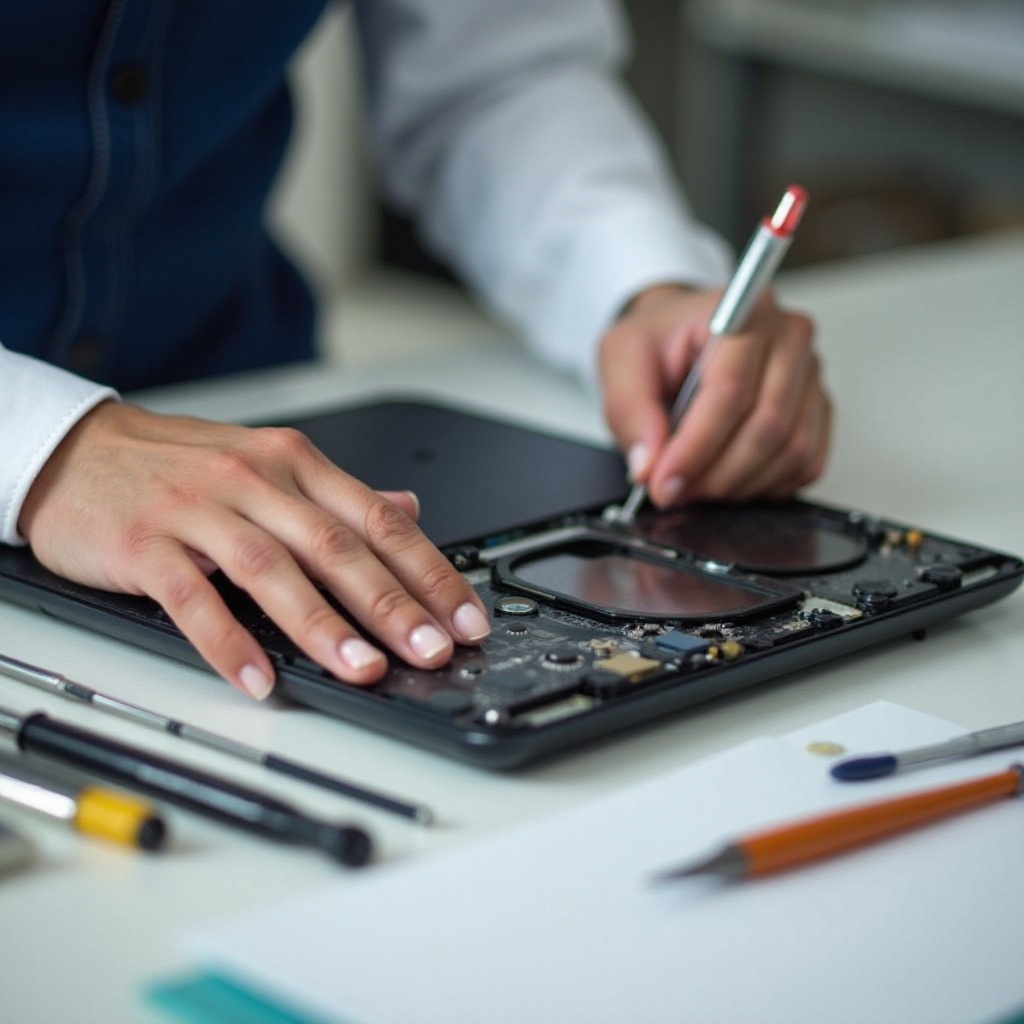Introduction
Typing on a laptop is an essential function for work, communication, and leisure. When the keyboard stops working, it can be incredibly frustrating and disruptive. Addressing these typing issues quickly is crucial to minimizing downtime and restoring productivity. This guide will help you troubleshoot and fix keyboard issues systematically, whether they are caused by hardware or software problems.

Understanding the Problem
Before diving into the solutions, it’s important to understand the potential causes of your typing issues. Identifying whether the problem lies in hardware or software can save time and effort in finding the right solution.
Differentiating Hardware vs. Software Issues
Hardware issues usually involve physical damage to the keyboard, connections, or components. Symptoms include unresponsive keys, multiple keys activating at once, or visible damage.
Software issues, on the other hand, stem from problems within the operating system, drivers, or installed programs. Symptoms often include erratic behavior, input delays, or non-functional keys without any visible damage.
Common Symptoms
- Certain keys not responding
- Multiple characters appear when pressing a single key
- Keyboard types the wrong characters
- Unresponsive keyboard backlight
Identifying these symptoms can help you decide your next course of action.
Basic Troubleshooting Steps
Once you have identified the symptoms, you can begin with some basic troubleshooting steps.
Restarting Your Laptop
- Save your work and close all applications.
- Click the Start menu, select the power icon, and then click Restart.
- Once the laptop restarts, test the keyboard.
Checking for External Keyboard Issues
- Disconnect any external keyboards or devices.
- Check if the laptop's built-in keyboard starts working.
- If the issue persists, reconnect the external keyboard and test if it works.
Ensuring No Physical Obstructions
- Turn off and unplug the laptop.
- Check for debris or dust under the keys.
- Clean using compressed air or a soft brush.
Software Solutions
Software issues often require more in-depth solutions. Here are some steps you can take.
Updating Keyboard Drivers
- Go to Device Manager (right-click Start, select Device Manager).
- Expand Keyboards section.
- Right-click your keyboard device and select Update driver.
- Choose 'Search automatically for updated driver software.
Running System Updates
- Open Settings from the Start menu.
- Go to Update & Security.
- Click on Windows Update and then Check for updates.
- Install any available updates and restart your laptop.
Scanning for Malware
- Install a reputable antivirus program if you don't have one.
- Run a full system scan to detect and remove any malware.
- Restart your computer and test the keyboard.
Resetting Keyboard Settings
- Go to Settings > Time & Language > Language.
- Click on Keyboard and select your preferred input language.
- Click Options and then Add a keyboard to add the correct layout.
Advanced Troubleshooting
If basic software solutions haven’t worked, try these advanced methods.
Accessing and Resetting BIOS/UEFI Settings
- Restart your laptop and enter BIOS/UEFI (commonly by pressing F2, F10, or DEL during startup).
- Go to the Exit tab and select Load Setup Defaults.
- Save changes and exit BIOS/UEFI.
- Test the keyboard.
Booting in Safe Mode
- Open Settings and go to Update & Security.
- Click Recovery, then Restart now under Advanced startup.
- Go to Troubleshoot > Advanced options > Startup Settings > Restart.
- Press F4 to start in Safe Mode and test the keyboard.
Restoring Default Settings
- Open Control Panel and go to Ease of Access.
- Click Change how your keyboard works.
- Ensure that none of the options are checked (e.g., Sticky Keys, Filter Keys).
Hardware Fixes
If software solutions didn’t work, the issue might be hardware-related.
Physical Inspection and Cleaning
- Turn off and unplug the laptop.
- Use a can of compressed air to blow out any dust around and under the keys.
- If keys are still stuck, use isopropyl alcohol and a cotton swab to clean the individual keys.
Reconnecting Ribbon Cables
- Turn off and unplug the laptop.
- Remove the back panel to access the keyboard ribbon.
- Carefully reconnect the ribbon cable and ensure it's secure.
When to Replace the Keyboard
- Severe physical damage (e.g., water damage, broken keys).
- Repeated issues despite software fixes.
- Purchase and install a replacement keyboard following your laptop’s manual or seek professional help.

Professional Help
If all else fails, professional assistance is the best course of action.
When to Consult a Technician
- Persistent hardware problems.
- Inability to solve the issue using DIY methods.
- Need for quick and reliable results.
Cost Considerations
Professional repairs can vary in cost. Check your warranty status first, as some issues may be covered. Compare service quotes from various providers before proceeding.

Preventive Measures
Regular maintenance can prevent future typing issues and extend the life of your keyboard.
Regular Maintenance Tips
- Clean your keyboard weekly using compressed air.
- Avoid eating or drinking near your laptop.
Best Practices for Laptop Care
- Store the laptop in a protective case.
- Avoid placing heavy objects on the keyboard.
- Always keep your software and drivers updated.
Conclusion
Keyboard issues on your laptop can be frustrating, but with systematic troubleshooting, you can identify and fix most problems yourself. Whether the issue is software or hardware-related, this guide provides comprehensive steps to restore your typing functionality quickly. Don't let a non-functional keyboard disrupt your day—take action and get back to work seamlessly.
Frequently Asked Questions
How do I know if my keyboard issue is hardware or software related?
Check for visible physical damage or debris. If there’s none, update drivers and check software settings. Hardware problems often show physical signs or persist despite software fixes.
What’s the easiest way to clean my laptop keyboard?
Use a can of compressed air to blow out dust and debris. For thorough cleaning, use isopropyl alcohol and a soft cloth to wipe the keys.
Should I attempt to replace my keyboard myself or seek professional help?
If you’re comfortable with basic repairs and your laptop isn’t under warranty, you can attempt it yourself. Otherwise, professional help ensures a safer and more reliable fix.
